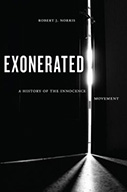The Exonerated: A History Of The Innocence Movement

Author: Robert J. Norris
Publisher: New York: New York University Press, 2017. 304p.
Reviewer: Tucker Carrington | March 2018
Perhaps one of the most visible consequences of the “innocence movement” is its ability to harness publicity. Each innocence narrative – and to date the Innocence Project lists over 300 post-conviction exonerations – is a gripping story, many of them well-publicized, others turned into feature films and wildly popular podcasts. Added to this are the exonerations’ multiple by-products: fascinating insights into the systemic failings of the criminal justice system, many of which have been studied and discussed widely. Surprisingly, however, Professor Robert J. Norris’ book, Exonerated: A History of the Innocence Movement, is the first complete and exhaustive treatment of the movement itself. The book offers a deep dive. The fact that it is nonetheless eminently readable speaks to Norris’s ability to merge impressive scholarship and research with fascinating stories, interesting interviews and anecdotal information. The result is an impressive history layered over with entertaining color. The book is a welcome addition for a host of readers – from those who may already be familiar with innocence work to those who are new to it.
Norris’ approach to recounting this history– what he terms the “political process model” – posits that opportunity and organizational strength coalesce to take advantage of “structural potential.” He sets the stage for his argument with one of the earliest innocence studies, Edwin Borchard’s 1932 book, Convicting the Innocent, and closes the curtain nearly a century later with a series of thoughtful assessments about the rightful definition and place of the “innocence movement.” In between, Norris documents the birth of the movement — namely the early work in the 1970s and 80s by Centurion Ministries, journalist Rob Warden and Professor Samuel Gross, among others. Norris notes correctly that “this time period is sometimes overlooked . . . but these events should not go un-noticed. The provide the first clues that something was there, that wrongful convictions may be more than mere aberrations, and that they deserve attention.” Norris then explores the advent and evolution of DNA technology in criminal cases by tracing what he argues was the “first” DNA-exoneration case, the little-known case of David Vasquez in Virginia. With this as background, the first portion of the book turns to the Barry Scheck and Peter Neufeld’s founding of the Innocence Project at Cardozo Law School and the beginning of the contemporary “innocence movement.”
Norris argues that the movement’s most important and lasting development was the idea — and then creation — of a national network of organizations devoted in whole or in significant part to innocence work. Barry Scheck, who had initially proposed the idea, hoped that at some point there would be either an innocence project in every state or a network of projects that together could provide services nationally. By 2000 there were ten such projects in place; today there are dozens, several of which are based in foreign countries. Norris’ also explains the movement’s success by explaining that it did not occur in a vacuum, that, instead, there existed a multi-faceted context – including the development of “conviction integrity units” in a number of prosecutors’ offices throughout the country, the National Academy of Sciences 2009 sweeping critique of forensic disciplines in Strengthening Forensic Sciences in the United States: A Path Forward, and a notable dissent in the 2015 United States Supreme Court case, Glossip v. Gross, which argued that underlying the death penalty’s unreliability was “convincing evidence that . . . innocent people have been executed.”
Norris concludes with a thoughtful assessment of precisely what type of “movement” the innocence movement is — whether it’s a true civil rights movement at all, or something different. In a certain sense this is the most interesting part of the book, driven as it is by thoughtful and energetic opinion by persons both inside and outside of the innocence community, including lawyers, non-lawyers, and journalists. The energy, thoughtfulness and host of opinions suggest that the innocence phenomenon is still evolving, and that those at its core are content to let the work speak for itself and evolve. To the extent that the movement’s next phase is as consequential as its first, readers should hope Professor Norris authors the follow-up.
Tucker Carrington, Assistant Professor of Law and Director, George C. Cochran Innocence Project, The University of Mississippi School of Law


